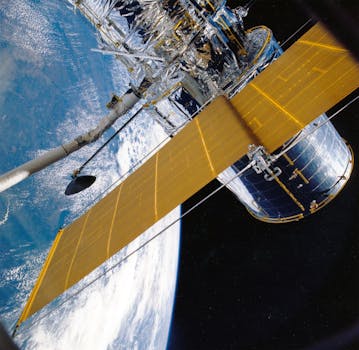GEO Satellites: Understanding the Technology and Applications of Geostationary Orbit Satellites

GEO Satellites: Introduction to Geostationary Orbit Satellites
GEO satellites, or geostationary orbit satellites, are a type of satellite that orbits the Earth at an altitude of approximately 36,000 kilometers above the equator. This specific orbit allows the satellite to remain stationary relative to a fixed point on the Earth’s surface, providing a constant and reliable connection. The focus keyword GEO satellites is essential in understanding the technology and applications of these satellites. At the beginning of our content, we will explore the world of GEO satellites and their significance in modern telecommunications.
The concept of GEO satellites was first proposed by scientist Arthur C. Clarke in 1945, and the first geostationary satellite, Syncom 2, was launched in 1963. Since then, GEO satellites have become a cornerstone of modern telecommunications, enabling global connectivity, navigation, and remote sensing. The use of GEO satellites has revolutionized the way we communicate, navigate, and monitor the Earth’s surface.
How GEO Satellites Work
GEO satellites work by transmitting and receiving signals to and from Earth-based stations. The satellite’s antenna receives signals from the Earth station, amplifies them, and then retransmits them back to Earth, allowing for communication between two distant points. The geostationary orbit ensures that the satellite remains stationary relative to the Earth, providing a constant and reliable connection. The technology behind GEO satellites is complex and involves advanced systems for signal transmission, reception, and processing.
The benefits of GEO satellites are numerous. They provide global coverage, enabling communication and navigation services to be accessed from anywhere in the world. GEO satellites also offer high-gain antennas, which allow for strong and reliable signals, making them ideal for applications such as television broadcasting and telecommunications. The use of GEO satellites has enabled the development of modern technologies such as GPS, satellite TV, and mobile communications.
Applications of GEO Satellites
GEO satellites have a wide range of applications in various fields, including telecommunications, navigation, remote sensing, and weather forecasting. They are used for television broadcasting, providing global coverage and enabling people to access a wide range of channels and programs. GEO satellites are also used for mobile communications, enabling people to make calls and access the internet from anywhere in the world. The applications of GEO satellites are diverse and continue to expand as technology advances.
In addition to their use in telecommunications, GEO satellites are also used for navigation, providing location information and timing signals for GPS and other navigation systems. They are also used for remote sensing, enabling the collection of data on the Earth’s surface and atmosphere, which is used for applications such as climate monitoring and natural disaster prediction. The use of GEO satellites has enabled significant advancements in these fields and continues to play a vital role in modern society.
Future of GEO Satellites
The future of GEO satellites is exciting and promising. With the development of new technologies, such as high-throughput satellites and satellite constellations, the capabilities of GEO satellites are expanding rapidly. These new technologies enable faster data transfer rates, increased connectivity, and improved navigation and remote sensing capabilities. The future of GEO satellites is likely to involve the development of even more advanced technologies, enabling new applications and services that will transform the way we communicate, navigate, and monitor the Earth’s surface.
In conclusion, GEO satellites play a vital role in modern telecommunications and have numerous applications in various fields. Their technology, benefits, and uses are diverse and continue to expand as technology advances. As we look to the future, it is clear that GEO satellites will remain a cornerstone of modern telecommunications, enabling global connectivity, navigation, and remote sensing.




